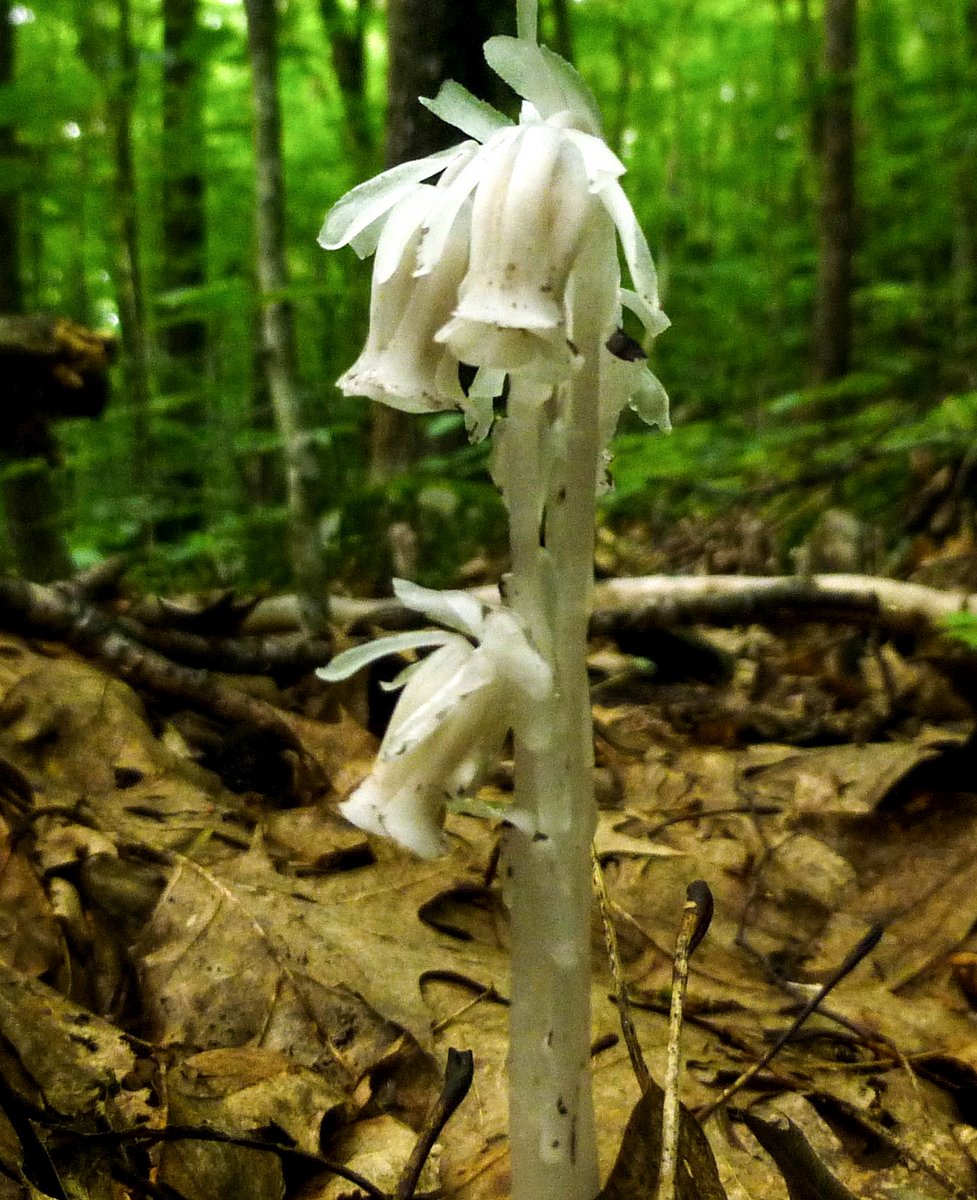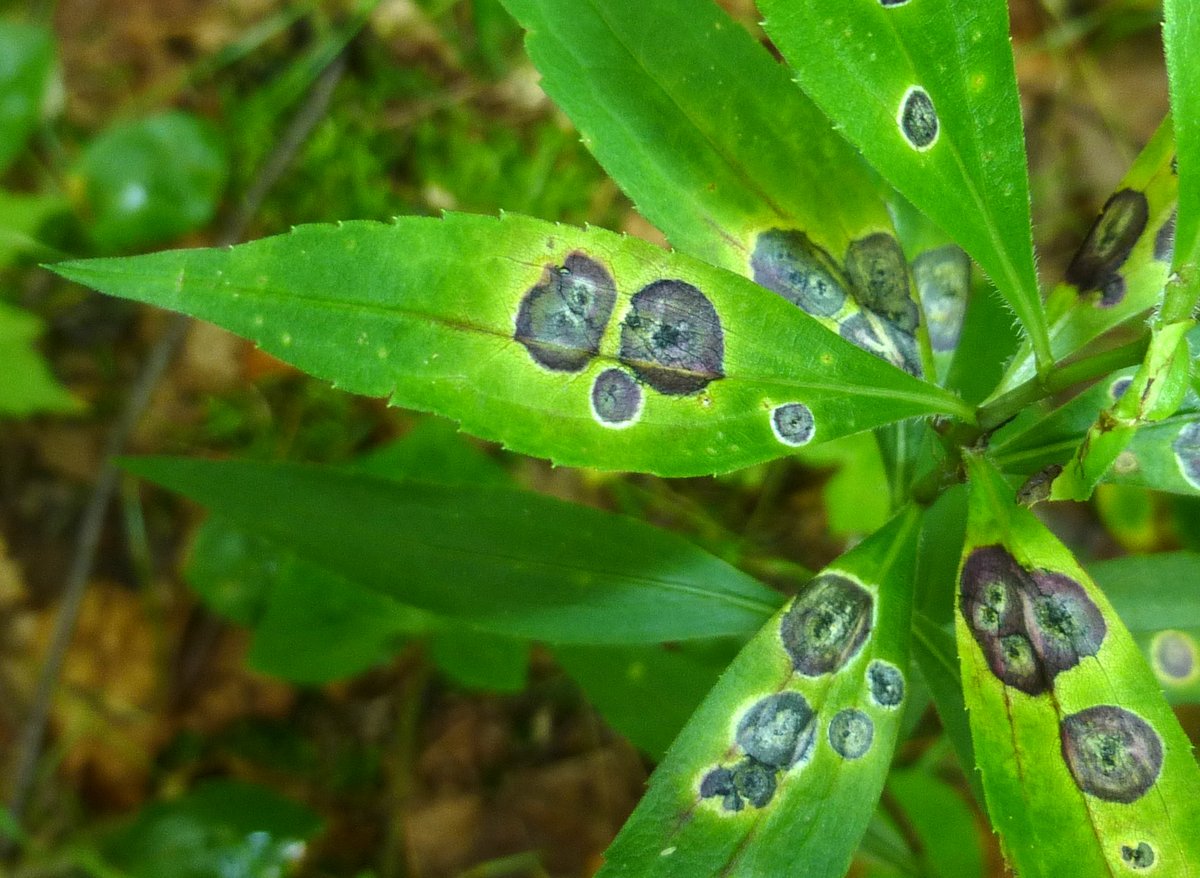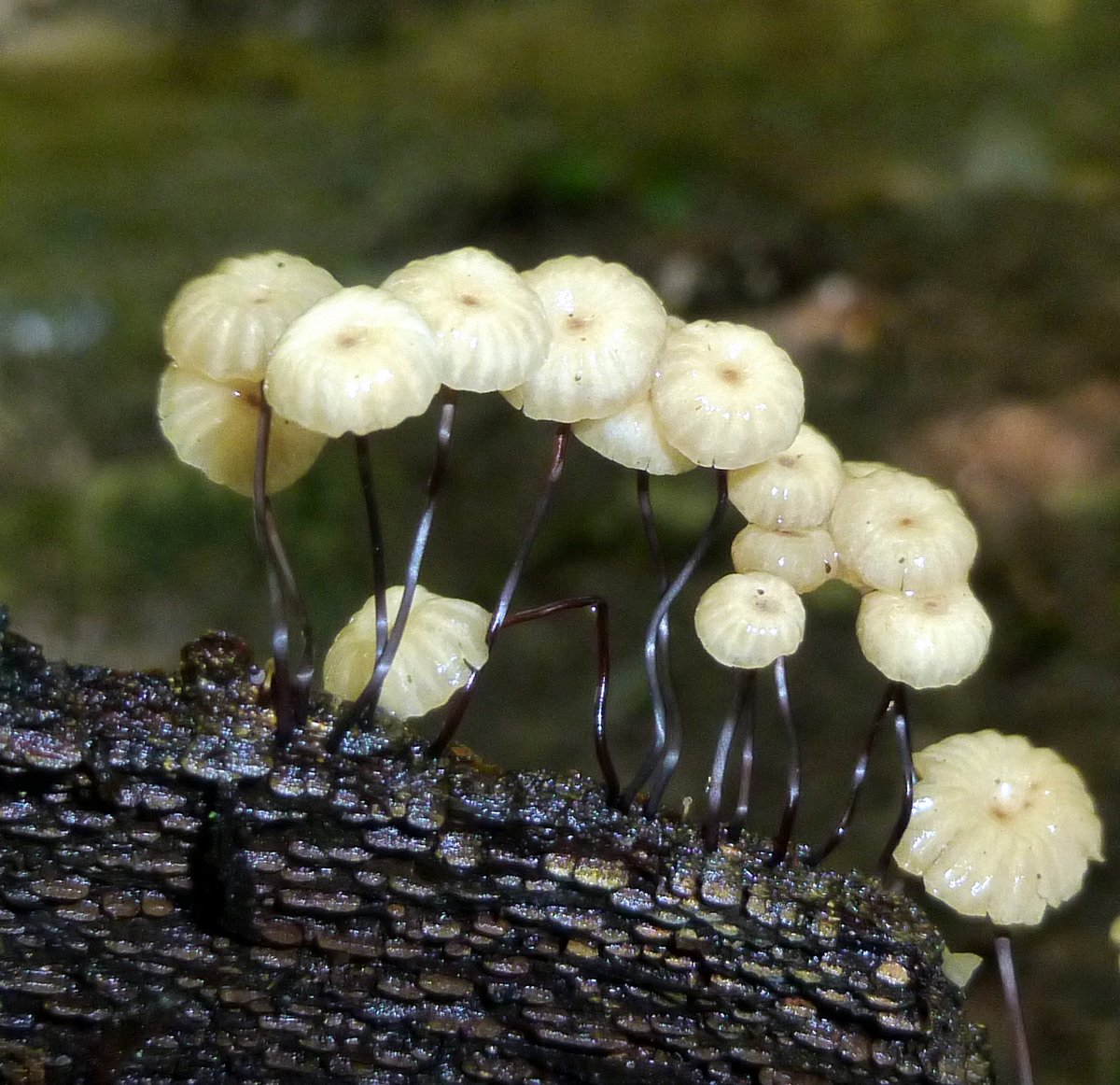
First come the yellow, red and orange mushrooms and then come the purples, and I’m seeing a lot of purple cort mushrooms (Cortinarius iodeoides) this year. I’ve noticed that this mushroom and virtually all of the orange ones are left untouched while white and other colors seem to be eaten almost as soon as they appear. Eaten by what I don’t know, but I assume it’s probably squirrels and chipmunks. Purple cort fungi have a rather bitter slime on their caps and that most likely accounts for their not being eaten.

A purple cort mushroom’s color lightens a bit as it ages, and it will often develop white or yellow streaks and spots as it ages. This is a good way to identify them.

The underside of a purple cort is very beautiful, in my opinion.

This butter waxcap (Hygrocybe ceracea) seemed to glow brightly in the dark of the forest. In this area I will now be seeing fewer and fewer orange and yellow fungi from this point on. Mushrooms have a “bloom time” just like flowers and the appearance of the purples tells me that the time for yellow and orange mushrooms is nearing an end.

Witch’s hat (Hygrocybe-conica) fungi have been everywhere this year. They’re quite small and easy to miss, or maybe I’ve just ignored them in the past. They’re also called conical wax caps. According to Mushroom expert.com they bruise to black quite easily. They start out bright red to bright orange, fading to orangish or yellowish and finally black. Though this one was dry they can sometimes look wet or slimy.

Yellow nolanea (Entoloma murrayi) is also known as the yellow unicorn mushroom because it sometimes has a knob, called an umbo, on the top of its conical cap. Mushroom books say that they are common in the woods, but they aren’t that common in this immediate area. I think this is the first one I’ve seen.

American slippery jack (Suillus americanus) mushrooms are also called sticky buns or chicken fat fungi. They are known for their yellow, slimy caps with reddish brown scales, and how they usually appear in great numbers under eastern white pine trees. There must have been a dozen or more in this spot when I took this photo; enough so it was hard to get a shot of a single example.

The stem of the American slippery Jack is narrow with reddish spots and large yellow, angular pores are found on the underside of the cap. It’s a very stiff, tough feeling stem. Science has found that this mushroom has anti inflammatory properties.

The lilac fiber cap mushroom (Inocybe geophylla var. lilacina) is the lilac color seen here but it has a white cousin. Even Mushroom Expert.com says this genus is “filled with confoundingly similar species,” and is impossible to be sure of without a microscopic look at its spores, so I could be wrong about its name. It’s a pretty mushroom that people like to find for just that reason. What I noticed beside its pretty color was how the cap did indeed look fibrous. It starts out purple and fades to brown.

Here is the underside of the lilac fiber cap. The gills start off white and slowly turn brown, but you can also see a hint of purple in these examples. This is a poisonous mushroom.

According to Wikipedia scaly rustgill fungi (Gymnopilus sapineus) grow in dense clusters on conifer logs. The yellowish caps are darker at the center with a dry, sometimes scaly surface which can be fibrillose. According to Mushroom Expert.com some guide books will say that the cap is scaly and others will say that it is smooth. I wanted to test Google lens on it to see how it did with mushrooms. It was close but it had the species wrong and the description it gave didn’t match what I’ve read elsewhere. DNA testing has shown that it is very similar to Gymnopilus penetrans, which is called the common rustgill. This common mushroom is often a bright spot in dark forests.

Clavaria ornatipes is described as a spatula or club shaped fungus, colored greyish to pinkish gray. These fungi shrivel when they dry out and revive after a rain. They grow directly out of the ground and there are often hundreds of them. I haven’t seen many coral type fungi this year so I was happy to see these.

In my last mushroom post I showed a Berkley’s polypore (Bondarzewia berkeleyi) that I had been watching grow for weeks. Now, more than a month later here it is, fully grown. I put a pocket knife up in the left corner so you could see how big it was. You can also see standing water in its center. Now this giant will begin to slowly decompose, and the odor will be easily detected from several yards away.

The scaly vase chanterelle (Turbinellus floccosus) is also called the wooly chanterelle. Sometimes it can have an orange cap like that seen in the above photo and sometimes it can be vase shaped. It likes to grow near conifers, and that’s where I found this one and several others. Though they might have chanterelle in their common name they can make you sick. They are said to be more closely related to stinkhorns than chanterelles.

Here’s a look at the outside of a younger scaly chanterelle, completely vase shaped. It is described as “shriveled looking but stout” and this one felt solid and heavy, like a club. The outside is creamy when young and then turns brownish.

There are many boletes that stain blue and they are easily misidentified, so I’ll just say that this is a bolete that stains blue. Many blue staining boletes are also poisonous.

Though there are gilled boletes most have pores or tubes on the undersurface as this one did. Sometimes the underside of the cap is a different color but the color of this one was fairly uniform all over.

Uniformly colored that is until it was cut, and then the flesh turned blue. I’ve seen boletes stain a beautiful, indigo blue instantly when damaged but this was a lighter blue that took a minute or two to show. If you happen to know its name, I’d love to hear from you.

Seeing big mushrooms is easy, but to see small ones you need to re-train your eyes. (And your mind, somewhat.) Jelly babies (Leotia lubrica) taught me that one day when I accidentally saw them; they helped me see that forests are full of things just as small and sometimes many times smaller. Once you train your eyes to see small things before long, you’ll be able to see them everywhere and a whole new chapter in the book of nature will open for you. Despite their name jelly babies are sac fungi rather than jelly fungi.

I thought I’d never see a mushroom smaller than jelly babies but I was wrong. These fuzzy foot mushrooms (Xeromphalina campanella) were the smallest I’ve seen. Many of the mushrooms seen in this photo were barely as big as a pea and some were even smaller. The Xeromphalina part of the common name means “little dry navel” and points to the dimple that forms in the cap as it grows and expands. This mushroom grows on wood and this particular species prefers conifers. There is another that prefers hardwoods called Xeromphalina kauffmanii. Both are known for their ability to fruit in large numbers. I think there was an eastern hemlock stump under all that moss.

Everything in nature gets eaten, but something that is rare to see is a mushroom with another fungus feeding on it, like this one with a mycoparasite called Syzygites megalocarpus growing on its cap. A mycoparasite is essentially a fungus (pin mold) that feeds on other fungi. This one has been found on over 65 species of mushroom and it was the first fungus found to be capable of sexual reproduction. It can appear overnight if heat and humidity levels are just right. You can’t plan to see something like this. You have to be there when it happens, and that’s a good reason to spend as much time as possible in nature.

On older vermillion waxcaps (Hygrocybe miniata) the penny size cap can become a bit scaly and fade to orange a bit, as this one had. The margin also becomes scalloped with age as this one showed but even with all of that Mushroom Expert.com says that this pretty little mushroom can be confused with several others. In fact the web site says that miniata should mean “many look-alikes.” Actually it means red or vermillion.

The gills on a vermillion waxcap are pale yellow but fade a bit with age. The underside of this mushroom is very pretty, in my opinion. It looks like a very tiny spider might have been living among the gills.

I put this photo of a yellow fly agaric mushroom (Amanita muscaria var. formosa) here in this post to remind me to tell you that we’ve never seen as many of this mushroom as we’ve seen this year. They’re just about everywhere you look and some of the caps have flattened out and grown as large as dinner plates. This tells me that they like lots of rain and they do better when they get it. The white spots (called warts) are what are left of the universal veil that covered the mushroom when it was in the immature “egg” stage.

Another mushroom that is having a great year is the tiger’s eye mushroom (Coltricia perennis.) Something that makes it unusual is how it is one of the only polypores with a central stem. Most polypores are bracket or shelf fungi. The concentric rings of color are also unusual and make it look like a turkey tail fungus with a stem. The cap is very thin and flat like a table, and another name for it is the fairy stool. They are very tough and leathery and can persist for quite a long time. I find them in August through October. This year they have a lot of red in them.
I hope you enjoyed this second look at the summer fungi that have been popping up in this area. You don’t need to be a mycologist to enjoy their many interesting shapes and beautiful colors, so I hope you’ll look out for them.
Go out, go out I beg of you
And taste the beauty of the wild.
Behold the miracle of the earth
With all the wonder of a child.
~Edna Jaques
Thanks for stopping in.










































































